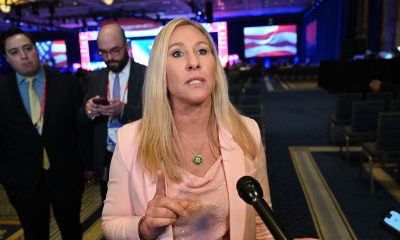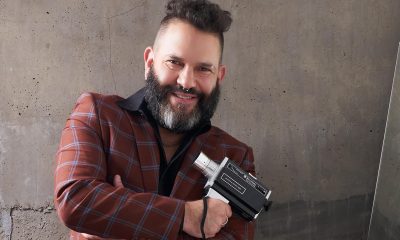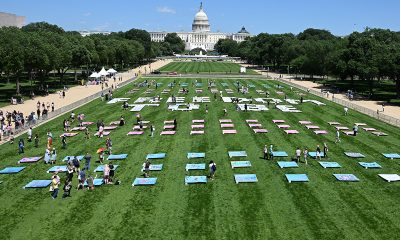Opinions
Proposed rules a good start, but some could threaten D.C. food trucks
Mobile kitchens should be treated like brick-and-mortar restaurants
By Ché Ruddell-Tabisola

Hungry patrons wait in line outside a popular Washington food truck. (Washington Blade file photo by Michael Key)
Many thanks to Mark Lee for raising the issue and to the Washington Blade for providing a forum to discuss something near to the hearts of many Washington, D.C., residents and workers: Their food trucks.
On Jan. 20, Mayor Vincent Gray proposed new food truck regulations, which were the result of the work of the District’s Department of Consumer and Regulatory Affairs (DCRA). The Washington, D.C. Food Trucks Association is grateful to Mayor Gray for his leadership in proposing new food truck regulations, which are badly outdated. Under current rules food trucks can be fined and/or shut down by police if we do not have a line of waiting customers. It is a policy that every day threatens the sustainability of our small businesses.
The proposed new food truck rules would remedy this problem. Overall, the proposed new rules are a significant improvement over current regulations, which is why the D.C. Food Trucks Association supports Mayor Gray’s proposal and is asking our fans and followers to support them too.
However, the proposed new rules also contain regulations that will continue to threaten our new and innovative small businesses. The proposed regulations would require dessert trucks to go no longer than 10 minutes without a line of waiting customers before risking being fined or closed by police. The D.C. Food Trucks Association believes dessert trucks should be treated the same as savory trucks. The proposed new rules would require food trucks to close at 10 p.m. on weekdays and 1 a.m. on weekends. We believe food trucks should be allowed to operate the same hours as brick-and-mortar restaurants. The new regulations also propose to create Vending Development Zones. We’re concerned that these zones could be manipulated to create “Food Truck-Free Zones.”
Lee raises a number of concerns about food truck regulations in his Feb. 10 op-ed. The D.C. Food Trucks Association believes that food truck rules should be made in the interest of public health and safety, and we currently follow a number of rules with that purpose.
Food trucks must meet the same health and safety requirements as brick-and-mortar restaurants. For example, food truck operators must be certified food protection managers in order to become a licensed vendor, and our mobile kitchens are inspected by the Department of Health twice a year (which is twice as often as brick-and-mortar restaurants). In addition to our mobile kitchens, food trucks must also maintain a brick-and-mortar commercial kitchen where we store and prepare food and that is also regularly inspected by the Department of Health.
Lee raises concerns about taxes paid by food truck operators. To clarify, food truck operators pay the same taxes as other District street vendors as well as payroll taxes, motor vehicle fees and District corporate/unincorporated business franchise taxes. Food truck operators whose brick-and-mortar kitchens are under triple net leases additionally pay the associated property taxes for those kitchens.
Lee also minimizes the threats that D.C. food trucks face. The truth is that D.C. food trucks continue to operate in an uneasy regulatory and political climate. Lee’s own comments are testament to that. One only needs to read comments sent to DCRA in 2010 in response to an earlier version of proposed new food truck rules to see evidence that D.C.’s food trucks are being assailed by draconian proposals not offered in the interest of public health but whose intent is to limit competition. Comments made at that time called for everything from implementing distance rules that effectively banned food trucks downtown, forcing food trucks to move every 30 minutes and asserting that food trucks were altogether illegal.
The heart of the current issue, and what the proposed new food truck regulations address, is that fining and/or closing a food truck because it does not have a line of waiting customers is wrong. A government rule that requires any business to have a sales floor, dining room or waiting queue of customers – or else face the prospect of being shut down by police – makes no sense, limits consumer choice and eliminates fair competition in the market place, which is bad policy for all businesses, not just food trucks. After all, in a free market, isn’t it the customer who decides and who goes?
The District is collecting comments about the new proposed regulations until March 1.
You can read the new proposed regulations at http://dcra.dc.gov/DC/DCRA/News%20Room/DC_Register_Proposed_Vending_Regulations_01.20.12.pdf and submit your comments to [email protected].
Ché Ruddell-Tabisola is executive director of the Washington, D.C. Food Trucks Association and co-owner of the BBQ Bus. Reach him via bbqbusdc.com.
Commentary
Second ‘lavender scare’ is harming our veterans. We know how to fix it
Out in National Security has built Trans Veterans State and Local Policy Toolkit

Seventy years after the first “lavender scare” drove LGBTQ Americans from public service, a second version is taking shape. Executive directives and administrative reviews have targeted transgender servicemembers and veterans, producing a new wave of quiet separations and lost benefits.
The policy language is technical, but the result is personal. Veterans who served honorably now face disrupted healthcare, delayed credentials, or housing barriers that no act of Congress ever required. Once again, Americans who met every standard of service are being told that their identity disqualifies them from stability.
Out in National Security built the Trans Veterans State and Local Policy Toolkit to change that. The toolkit gives state and local governments a practical path to repair harm through three measurable actions.
First, continuity of care. States can keep veterans covered by adopting presumptive Medicaid eligibility, aligning timelines with VA enrollment, and training providers in evidence-based gender-affirming care following the World Professional Association for Transgender Health Standards of Care Version 8.
Second, employment, and licensing. Governors and boards can recognize Department of Defense credentials, expedite licensing under existing reciprocity compacts, and ensure nondiscrimination in state veterans’ employment statutes.
Third, housing stability. States can designate transgender-veteran housing liaisons, expand voucher access, and enforce fair-housing protections that already exist in law.
Each step can be taken administratively within 90 days and requires no new federal legislation. The goal is straightforward: small, state-level reforms that yield rapid, measurable improvement in veterans’ daily lives.
The toolkit was introduced during a Veterans Week event hosted by the Center for American Progress, where federal and state leaders joined Out in National Security to highlight the first wave of state agencies adopting its recommendations. The discussion underscored how targeted, administrative reforms can strengthen veterans’ healthcare, employment, and housing outcomes without new legislation. Full materials and implementation resources are now available at outinnationalsecurity.org/public-policy/toolkit, developed in partnership with Minority Veterans of America, the Modern Military Association of America, SPARTA Pride, and the Human Rights Campaign.
These are technical fixes, but they carry moral weight. They reaffirm a basic democratic promise: service earns respect, not suspicion.
As a policy professional who has worked with veterans across the country, I see this moment as a test of civic integrity. The measure of a democracy is not only who it allows to serve but how it treats them afterward.
The second “lavender scare” will end when institutions at every level decide that inclusion is an obligation, not an exception. The toolkit offers a way to begin.
For more information or to access the toolkit once it is public, visit outinnationalsecurity.org/toolkit.
Lucas F. Schleusener is the CEO of Out in National Security.

For years, the far right has relied on a familiar infrastructure to wage its political battles: coordinated legal networks, back-channeled money, and an ever-growing pipeline of model legislation that moves quietly from one statehouse to another. What used to be a fringe ecosystem of activist lawyers has matured into something far more muscular. Today, the attacks on LGBTQ Americans—especially transgender people—are not random. They are designed, drafted, and deployed by a disciplined constellation of groups that understand how to move legislation with precision. And if Democrats, civil rights advocates, and national LGBTQ organizations continue treating each bill as an isolated outrage rather than a unified offensive, this machine will keep outpacing them.
Most Americans have never heard of outfits like the Alliance Defending Freedom, the American Principles Project, the Leadership Institute’s law arm, or the network of state-based policy shops that orbit the Heritage Foundation. But these entities now function as the shadow authors of state legislation. The anti-trans sports bans that appeared in more than 20 states did not arise organically; they were cloned from drafts circulated by ADF attorneys. The same is true for bills restricting gender-affirming care, limiting name and pronoun accommodations in schools, or expanding “religious liberty” carve-outs that allow discrimination against LGBTQ employees or customers. Legislators often change a few words, swap in a local sponsor, and reintroduce the same provisions session after session — giving the impression of momentum when, in reality, only a handful of ideologues are writing the nation’s culture-war script.
The operational model is simple: produce a bill, partner with a state-level think tank, recruit a legislator to introduce it, and provide legal testimony to defend it. But the strategic sophistication lies upstream. These groups have spent years cultivating relationships with attorneys general, state solicitors, and conservative judges who are sympathetic to their worldview. They draft legislation with litigation in mind, anticipating which language will survive scrutiny before the federal courts they have worked diligently to remake. They treat policy, politics, and jurisprudence as a seamless ecosystem; meanwhile, LGBTQ advocates are forced to fight on three fronts at once, often with smaller budgets and no comparable network of state-by-state affiliates.
What is most striking now is the acceleration. Bills that used to be test-driven in one or two states are being introduced in a dozen simultaneously. After the Supreme Court’s Dobbs decision, the same legal strategists pushing abortion bans pivoted almost immediately toward restricting trans health care, framing puberty blockers and hormone therapy as “sterilization.” The rhetorical shift was not accidental. It was a deliberate legal construction designed to open the door to future Fourteenth Amendment challenges, should the movement secure a case capable of reaching the Supreme Court. This is not simply a legislative fight; it is the groundwork for long-term judicial warfare.
And yet, Democrats and even national LGBTQ groups often treat these measures as if they were spontaneous outbursts of local prejudice. That is politically naïve. The reason similar bills appear in Idaho, Florida, Tennessee, Kansas, and Ohio at the same time is because they originate from the same set of PDFs stored on the same servers belonging to the same legal networks. The far right has embraced an industrial model of anti-LGBTQ policymaking: mass production, rapid deployment, and coordinated amplification by media channels that echo the same talking points across state lines.
The consequence is that the burden falls on queer people themselves—especially trans people—to respond to an avalanche of bills, hearings, lawsuits, and administrative changes that no individual or small advocacy team can fully track. When you have a network of attorneys feeding language to legislators, drafting amicus briefs, and preparing future litigation strategies in advance, you create an asymmetry that is difficult to counter with reactive press releases or one-off legal challenges. This imbalance of power is not about public opinion, which still supports LGBTQ equality by wide margins. It is about institutional positioning. The far right has placed its lawyers where the pressure points are: in state AG offices, in coordinated legislative caucuses, in judicial clerkships, and in the nonprofit legal trenches where issue fights are shaped long before the public hears about them.
There is a path forward, but it requires abandoning the old model of treating each bill as a separate emergency. LGBTQ organizations need a unified, long-range strategy that mirrors the discipline of the groups attacking them. That means state-by-state legal surveillance, rapid drafting of counter-model legislation, formal partnerships with progressive state AGs, and a standing litigation coalition capable of anticipating—not just responding to—legal threats. It also means investing in local leaders who understand that these bills are symptoms of a national machine, not quirks of their hometown politics.
What’s at stake here is nothing less than the architecture of civil rights in the United States. The far right is attempting to rewrite the legal landscape through volume and repetition, hoping courts will eventually treat these contrived bills as reflections of a shifting national consensus. They are betting that if they introduce enough legislation, in enough states, for enough years, the judiciary will reinterpret LGBTQ equality not as a settled constitutional principle but as a contested social question that can be narrowed or rolled back. Their ultimate goal is not just to restrict trans rights today but to lay the doctrinal groundwork for limiting LGBTQ protections for a generation.
The community can still win this fight, but only if it sees the battlefield clearly. These bills are not local skirmishes—they are coordinated acts of legal engineering. And it is time the pro-equality movement built an equally coordinated system to match them.
Isaac Amend is a writer based in the D.C. area. He is a transgender man and was featured in National Geographic’s ‘Gender Revolution’ documentary. He serves on the board of the LGBT Democrats of Virginia. Contact him on Instagram at @isaacamend
Opinions
Everything is Everything
Transformer’s 21st Annual Benefit Art Auction & Gala at the LINE DC November 19, 2025

In Washington, DC, art has never existed in isolation—it thrives where people gather and create. Art isn’t an accessory to the city’s identity—it’s foundational to it. This city was designed by artists, built by craftsmen, and has been continuously shaped by creative vision for more than two centuries. While other American cities grew organically around commerce or geography, Washington was imagined first, drawn by hand, and constructed as a deliberate artistic expression of democratic ideals. The result is a living gallery where public art doesn’t just reflect our history; it actively shapes how we understand citizenship, memory, and identity.
For 23 years, Transformer has been a cornerstone of DC’s contemporary art scene, committed to uplifting emerging and underrepresented artists who challenge boundaries and engage audiences with new experimental artistic concepts. On November 22, 2025, Transformer will host Everything is Everything, our 21st Annual Benefit Art Auction & Gala at the LINE DC, a night dedicated to celebrating the power of connection through art, performance, and community.
Everything is Everything is an extension of our non-profit organization’s cutting-edge vision, bringing together artists across different mediums, aesthetics, and walks of life. This philosophy embraces interconnectedness: where art, identity, and community are a part of the same living fabric. The gala brings together hundreds of people to celebrate art & artists, featuring over 140+ artworks in a public exhibition available for silent bidding. Guests also enjoy our innovative Artist Activated Experiences Lounge, featuring immersive installations by DC based queer artists Bumper, Katie Magician, Div0id, JaxKnife Complex, Stitches DC, Hennessey and Kunj.
In a time when queer and drag performers face renewed cultural and legislative attacks, Everything is Everything affirms that freedom of expression is not optional—it’s essential. Our “Celebration of DC Club Kids” pays tribute to DC’s legendary Club Kids and nightlife culture—those radiant spaces that have long nurtured queer creativity, self-expression, and freedom. Produced at the Gala in collaboration with queer artist collective haus of bambi, this performance honors our city’s history while celebrating the diversity and creativity that will continue to shape its future. Everything is Everything culminates in a show-stopping performance by iconic New York City based performance artist, cabaret singer, and drag artist Joey Arias.
As Transformer’s Everything is Everything Gala Committee, we’ve experienced firsthand how artists in DC transform spaces, challenge norms, and build community. The Gala is a celebration of that creativity and resilience. It is also a crucial act of support: proceeds from the Everything is Everything Benefit Art Auction & Gala directly supports artists while sustaining Transformer’s year-round exhibitions and programs that elevate emerging artists and arts leaders within DC and beyond. In doing so, Everything is Everything ensures that experimental and inclusive artistic practice, particularly of queer, trans, and BIPOC artists, continues to thrive.
Because in DC, art isn’t just something we look at—it’s something we live, share, and fight to protect.
Purchase tickets to Everything is Everything, Transformer’s Annual Benefit Art Auction & Gala at onecau.se/everythingiseverything. Learn more about Transformer’s mission at www.transformerdc.org.
- Transformer’s Everything is Everything Gala Committee: Allana D’Amico, Sondra Fein, Theresa Nielson, Jennifer Sakai, Christopher Addison, Monica Alford, Samantha Dean, Samira Farmer, Carole Feld, Celina Gerbic, Ally Helmers, Allison Marvin, Marissa McBride, Tom Noll, Crystal Patterson, Victoria Reis, Dorothy Stein, Emily Strulson, Gregg Tourville, José Alberto Uclés, and Hanna Thompson

















